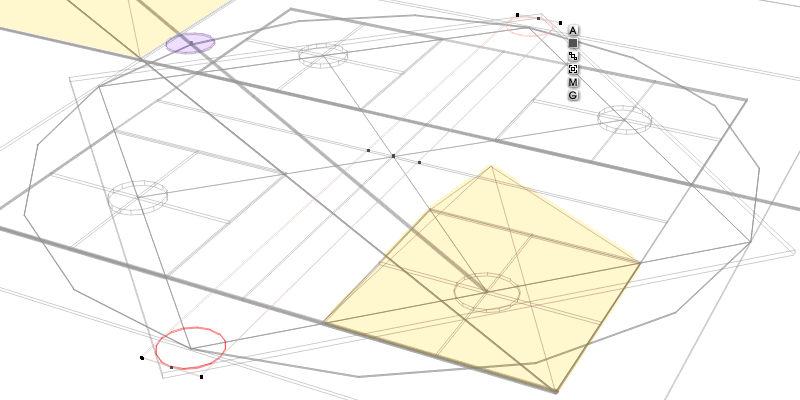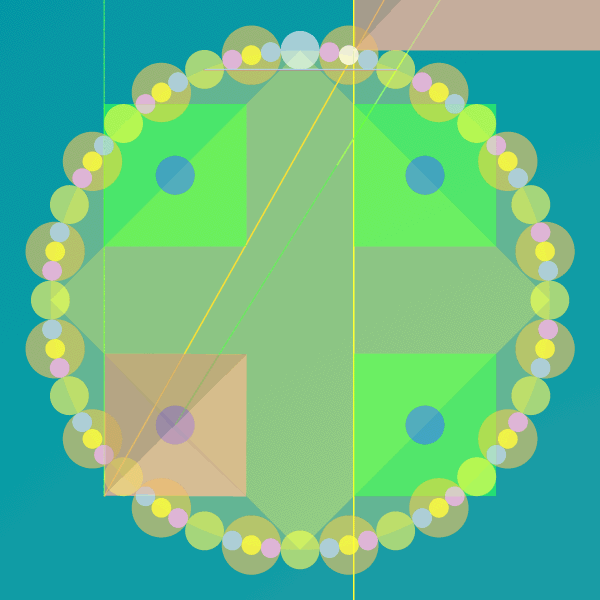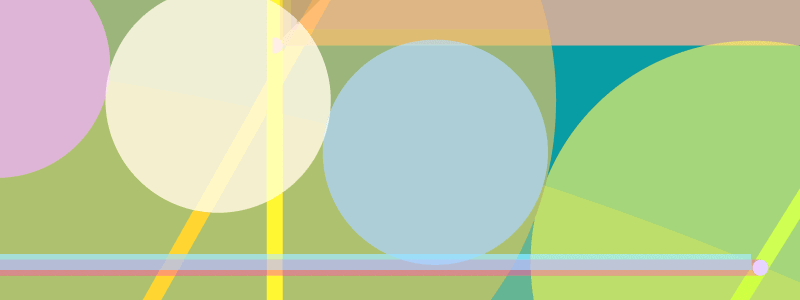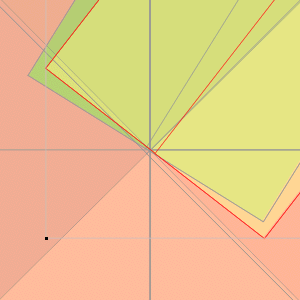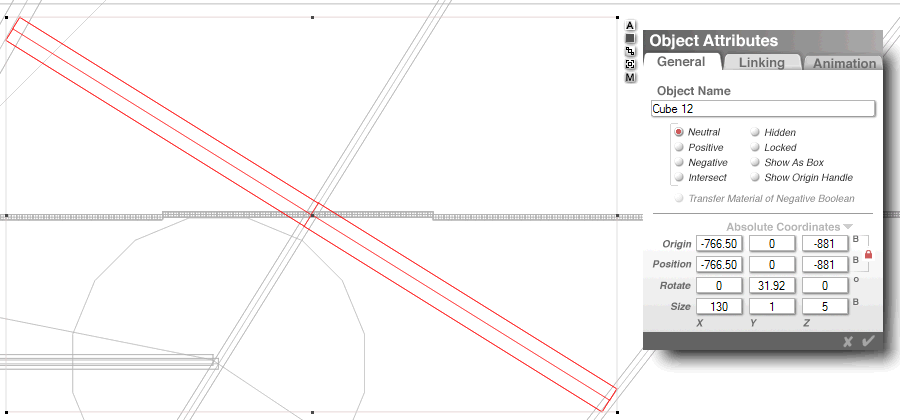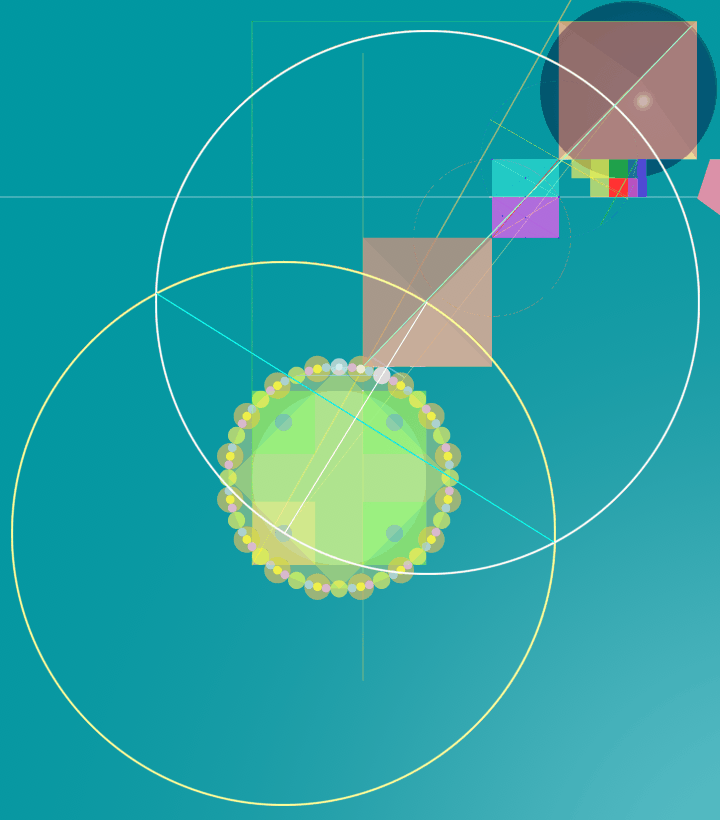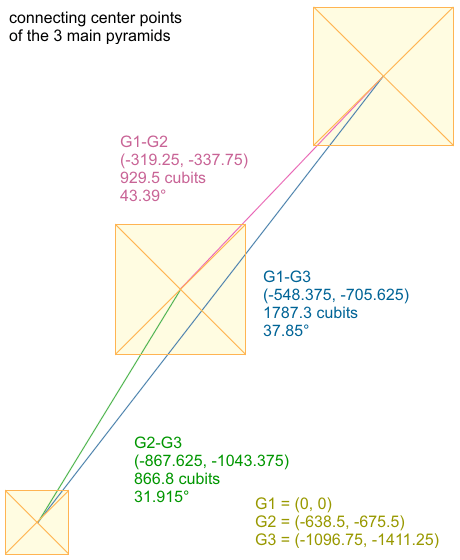 |
G1-G2: (-319.25, -337.75)
929.5 cubits, 43.39�
|
G2-G3: (-867.625, -1043.375)
866.8 cubits, 31.915�
|
G1-G3: (-548.375, -705.625)
1787.3 cubits, 37.85�
|
|
|
|
coordinates (in cubits)
for the pyramid centers
(relevant to G1 center)
|
G1 = (0, 0)
G2 = (-638.5, -675.5)
G3 = (-1096.75, -1411.25)
|
G1 = (0, 0)
G1G2 (-319.25, -337.75)
G2 = (-638.5, -675.5)
|
G1 = (0, 0)
G1G3 (-548.375, -705.625)
G3 = (-1096.75, -1411.25)
|
|
|
connecting to G1 is easy to figure...
just divide the other numbers in half
|
|
|
|
but, connecting G2 to G3
requires some basic math
|
G2 = (-638.5, -675.5)
(-......, -......)
G3 = (-1096.75, -1411.25)
1096.75 1411.25
- 638.5 - 675.5
= 458.25 = 735.75
/2 229.125 /2 367.875
+ 638.5 + 675.5
= 867.625 = 1043.375
|
G2 = (-638.5, -675.5)
G2G3 (-867.625, -1043.375)
G3 = (-1096.75, -1411.25)
|
|
|
...so, they're going to be
hundreds of cubits long...
and probably at odd angles
|
and at this distance...
a hundredth of a degree
...is apparent, visibly
|
|
|
...a minute of arc is
...a 60th of a degree
...and bigger than a 100th
...by almost twice as much
if it were a 50th of a degree
it'd be exactly twice as much
...see, now you feel silly...
|
...anyways...
60 is to 100:
as 6 is to 10
and 3 is to 5
(6:10... 3:5)
..phi ratio..
...here, also
|
...a degree of a circle is
divided up into 60 minutes
...so, 1/10 of a degree...
is comprised of 6 minutes
one of those minutes is
one sixth of that, or
0.016666,,, degrees
|
|
|
base 10 decimal system
to a 360 degree circle
|
so that's the relationship...
six tenths... three fifths...
|
...60 x 60 = 3600
seconds per degree
|
|
|
a hundredth of a degree is ten sixths
or, five thirds of a minute of arc...
one and two thirds or 1.66... minutes
...further delineating... 100 seconds
|
...see how that works out...
(it reflects back on itself)
one hundredth of a degree is
...100 seconds (of a degree)
|
(10/60)
x (10/60)
= 100/3600
or 1/36
|
|
| |
|
G1G2: 43.39 - 45 = -1.61
(phi, but it's degrees)
|
G2G3: 31.92 - 30 = 1.92
(phi plus pi, certainly)
|
|
|
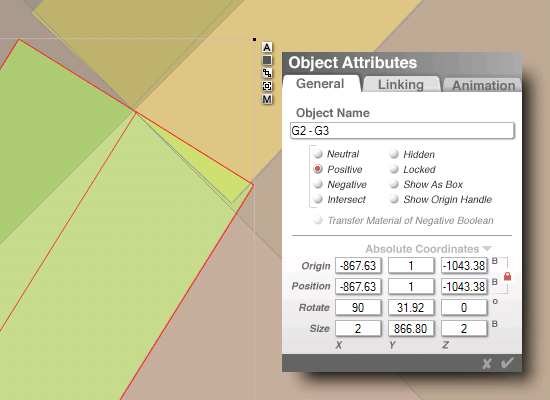 |
...G2 center...
...to G3 center...
(-867.625,-1043.375)
again, 2 cubits wide
green line this time:
and it's even closer,
by about half as much
|
866.80 cubits... and
31.915� puts it even
with the G1-G2 line
|
|
|
right image is at G3 center
below images are at G3 center
|
|
|
|
|
the purple dot is from the G3 rotator
(remembering there was some confusion
as to where, exactly... G3 should be)
G3 = (-1096.75, -1411.25)
dot = (-1096.78, -1411.28)
(i left it in, to remember)
|
|
|
but look at this:
..(right image)..
..(blue circle)..
(in this program)
in wireframe mode
round objects are
represented... as
16 sided polygons
(so lucky for us)
the red G2G3 line
is shown crossing
the G3 rotator...
(where i left it)
right at a corner
at 1/16 clockwise
or 22.50� exactly
|
|
|
that other angled object:
(gray, unselected) is GPH
the grand plan hypotenuse
running from G1nw to G3sw
...and... notice where it
intersects the SE corner
of the NW mirror of G3
...(orange circle)...
not a coincidence...
|
|
|
|
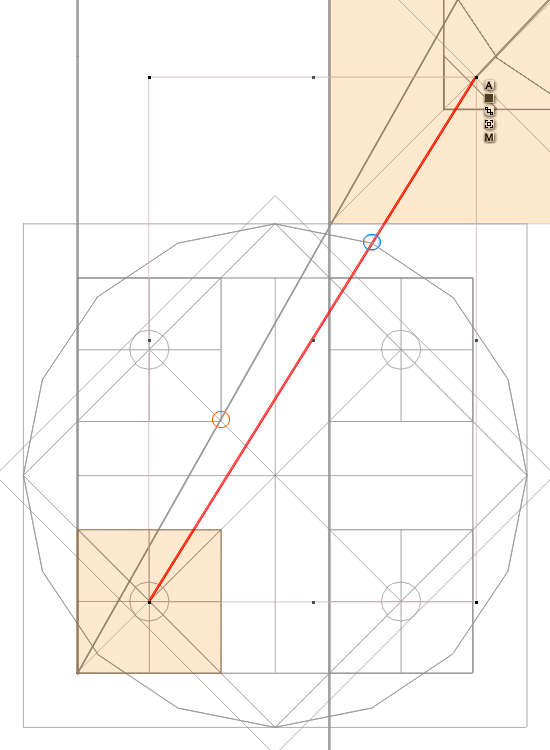 |
...as discussed on page 1...
the circle's diameter is 707
...at coords: (-920, 1234.5)
nice easy number to remember
|
|
|
707/2 = 353.5
-920 + 353.5 = 566.5
-920 - 353.5 = 1273.5
|
|
|
...so i'll put some
new dots down at...
(-1273.5, -1234.5)
(-566.5, -1234.5)
|
|
|
|
|
|
